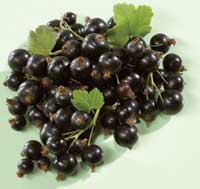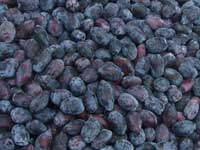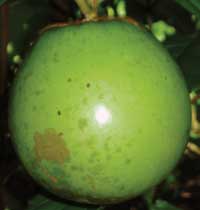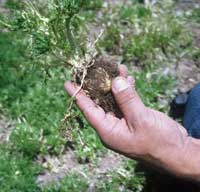Back to Basics
On December 29 of last year, the Journal of the American Medical Association (JAMA) announced the publication of a National Institutes of Health (NIH)-sponsored study claiming that Ginkgo biloba extract does not appear to slow the rate of cognitive decline. The announcement, made during what is typically a slow news week, became a headliner.
Originally Published NO May 2010

On December 29 of last year, the Journal of the American Medical Association (JAMA) announced the publication of a National Institutes of Health (NIH)-sponsored study claiming that Ginkgo biloba extract does not appear to slow the rate of cognitive decline. The announcement, made during what is typically a slow news week, became a headliner.
Reporters seized on the negative news about one of the top-selling herbal supplements in the United States. On his program, NBC Nightly News anchor Brian Williams declared: "Now a major study shows one of the most popular supplements flat out does not work."
NBC's chief science correspondent, Robert Bazell, concluded, "I think this really puts the nail on the coffin of Ginkgo biloba having any effect on memory...Even though there have been a few anecdotal and small studies suggesting that [ginkgo] might work, it just doesn't."
These condemnations rankled the botanical community for many reasons-including the fact that herbal experts had identified several serious design flaws in the ginkgo study.
An Imperfect World
The JAMA-published article was a secondary analysis of an original study, known as the Ginkgo Evaluation of Memory study, published in November 2008. Initially, the study had been designed to determine whether ginkgo extract prevented the onset of dementia. Botanical experts say that the study's scientists did not start measuring for the second outcome, or endpoint-that is, whether ginkgo actually slows the rate of cognitive decline-until two years after the study began. "When you go from a study whose primary endpoint is designed to look at outcome A, and then start looking at that same study for outcome B, that weakens the study," says Douglas MacKay, ND, vice president of scientific and regulatory affairs for the Council for Responsible Nutrition (Washington, DC).
Furthermore, the study tested subjects ages 72 years and older, disregarding the large group of middle-aged people who use ginkgo for cognitive health. Another significant glitch? The study saw a 40% dropout rate. Flaws such as these rendered the study inconclusive, said experts.
The ginkgo study is not the only scientific study on a botanical to see design flaws. "The fact is there are design flaws, deficiencies, and weaknesses associated with many, if not most, clinical trials, whether they are evaluating dietary supplements or conventional medicines. That is true of those that have negative results, and that is also true of those that have positive results," says Mark Blumenthal, executive director of the American Botanical Council (Austin, TX).
Or, as MacKay says, "It's an imperfect world, and designing studies is a very difficult thing to do."
While all studies may be difficult to design flawlessly, experts point out an additional challenge when designing trials for botanicals-that for several reasons, if scientists don't know how to properly work with them, botanicals may not always be the best fit for today's gold standard of a randomized, double-blind, placebo-controlled human clinical trial.
STERILIZATION OF BOTANICAL INGREDIENTS: SAFE AND LEGAL
By Walt Postelwait, BI Nutraceuticals
ALL WILDCRAFTED AND CULTIVATED HERBS contain a certain degree of microbes, including molds and yeasts, as well as both nonpathogenic and potentially harmful bacteria. These microbes must be reduced to acceptable levels in order to provide a product that is safe for human consumption.
Because botanical ingredients often exceed established specifications for microbial load, they generally require some form of sterilization. However, two of the most commonly used forms of sterilization in the industry-ethylene oxide (EtO) and irradiation-not only pose safety concerns, they are also currently illegal for use in dietary supplements.
Prohibition of EtO
The Federal Food, Drug, and Cosmetic Act (FFDCA) defines adulterated food as any food that "bears or contains a pesticide chemical residue that is unsafe within the meaning of section 346(a)" of the FFDCA (21 U.S.C. Sec. 342). Section 346(a) sets limits on pesticide chemical residues. EtO is a pesticide. Therefore, barring an exception, the only way it is legal to use EtO as a sterilization method is if a tolerance for EtO residue on a particular food has been established. Since there is not an established tolerance for EtO for use on herbs, EtO is not considered an acceptable method of herbal sterilization. Accordingly, any herb treated with EtO would be considered adulterated.
Additionally, EtO has been included on California's Proposition 65 list of chemicals known to cause cancer or reproductive toxicity since 1987, and has been banned by the 27 member states of the European Union, as well as Belize, Burundi (Africa), Cambodia, and Malaysia.

Prohibition of Irradiation
By law, every food that is irradiated must be approved individually by the Food and Drug Administration (FDA) and bear the Radura symbol, the international symbol indicating that a food has undergone irradiation. In the preamble to the current good manufacturing practices (CGMPs), FDA states that it is currently reviewing a food additive petition for the use of irradiation on dietary ingredients and dietary supplements. Until the review process is completed, however, the agency says that "irradiation of dietary ingredients and dietary supplements as a means to reduce or eliminate microbial loads is not permitted."
Of note: the American Herbal Products Association has submitted a letter to FDA requesting the agency deny the petition. Like EtO, irradiation is also prohibited throughout Europe.
Penalties for Breaking the Law
According to an FDA official, use of irradiation and EtO will be reviewed during CGMP inspections. "When we're at the manufacturing facility, we look at what processes they're using," said the official, who declined to be named. "And if the manufacturer is getting ingredients from other facilities, they need to have the appropriate specifications in place to make sure that the material they're getting is what it purports to be, so that there is a big onus on the finished-product manufacturer to make sure that what they're using is appropriate."
This is a substantial burden on manufacturers, as they have the potential to incur penalties for selling products treated with ionizing radiation, EtO, or other adulterants. The FDA official explains more about what types of products qualify as adulterated. "A product that would be irradiated, because we don't have a food additive petition in place, would be considered to be adulterated. A product that has an illegal pesticide would also be considered to be adulterated, so conceivably, a firm could receive a warning letter if we had evidence of that-or we could seize the product or enjoin the firm from doing those practices." Additionally, repeat violators could be hit with a permanent injunction, which would essentially put them out of business.
Legal Alternatives
Recently, several alternative sterilization techniques have been developed, including high heat, ozone, hydrogen peroxide, and steam sterilization. Of those, dry steam sterilization shows the most promise. The process involves treating herbal materials with steam at a high temperature under pressure for a specified amount of time. Unlike EtO and irradiation, the process does not leave any toxic residue and is completely natural and environmentally friendly. It has been certified organic by Quality Assurance International.
Whichever method suppliers choose to sterilize their botanical ingredients, one thing is clear: irradiation and EtO are not allowed. Since manufacturers are ultimately responsible for the ingredients used in their products, they will want to get assurance from their suppliers that their botanical ingredients have not been processed using either of these methods.
Walt Postelwait is vice president, marketing and sales, Americas and Europe, for BI Nutraceuticals. Postelwait is responsible for the sales and marketing portfolios across all of BI's business in the nutraceutical, custom blend, food, and beverage markets. Prior to joining BI, Postelwait was vice president and general manager of Blue Pacific Flavors and Fragrances and also managed several business units at Degussa Flavors & Fruit Systems, now part of Cargill..
The Drug Model
Randomized, double-blind, placebo-controlled trials used by the pharmaceutical industry to test drugs are also used in botanicals research. However, there are key differences between botanicals and drugs.
For instance, conventional drugs can be more easily controlled in a clinical study because they often comprise a single active constituent. "It's simpler for science to investigate when you reduce the number of variables," says MacKay. "It becomes much more complicated when you have multiple constituents."
And that's just what botanicals are-a complex host of hundreds, if not thousands, of constituents. Blumenthal notes that famed American botanist James A. Duke referred to botanicals as "chemical soup."
"When you make coffee or herbal tea, whether it's chamomile or peppermint or ginger, you're making herbal soup, an herbal cocktail with hundreds of chemicals in it-not just the stuff that has a good flavor, but all kinds of constituents that may, for example, have antioxidant or inflammatory or pro-inflammatory effects," says Blumenthal.
Moreover, unlike drugs, which can be consistently and identically reproduced, each plant is, to an extent, individualized. There are seasonal plant variations and different growing conditions, and even different harvesting, storage, and processing conditions, that may cause plants of the same species to differ slightly in their chemistry. This can make characterizing and obtaining consistent study material difficult.
As MacKay says, "Every time you eat an apple, it's not the exact same apple."
Crude plant extracts are also nuanced, and their constituents' effects can be difficult to determine because constituents often synergize to provide an overall health effect. "One compound may support the actions of another compound, and one compound may actually reduce the toxicity of another compound," says MacKay.
Another reason that drugs can be more ably studied in shorter trials like typical randomized clinical trials is that they contain highly purified, concentrated doses of an active ingredient. In a crude plant, active constituents are present at far lower, diluted levels. Thus, because drugs' active ingredients are stronger, their effects on the body can usually be judged in a much shorter period of time.
"A food or a supplement provides very small doses of an active ingredient, which may need to be given for long periods of time in order to have an effect on a disease that may take decades to evolve," says Sunil Chacko, MD, MPH, MBA, adjunct professor of health sciences at Canada's Simon Fraser University in Vancouver and a current scientific committee member of Canada's National Centre of Excellence: Advanced Foods and Materials Network. "Nutritional factors are different from drugs, because nutritional factors are small doses over long periods of time. So you're dealing with two totally different scenarios-and using the drug model to test foods and supplements is not appropriate."
Despite these crucial differences, randomized controlled trials, best for a quick-acting, single constituent and a single mode of action, continue to be used to study botanicals.
Herbalists argue that if we're going to rely so heavily on the outcomes of randomized controlled trials, we may at least want to make an effort to balance our conclusions with the body of scientific evidence that has built up around botanicals throughout the years.
"We have to look at the totality of evidence that supports whatever the most recent study purports to evaluate," says Blumenthal.
Also, when balancing evidence, keep in mind how modern studies of a botanical may differ from how that botanical has been historically studied. For instance, says Blumenthal, modern science has only been studying standardized ginkgo extract for its cognitive effects starting 35 or so years ago, when scientists at W. Schwabe Pharmaceuticals in Germany began studying ginkgo as a pharmaceutically prepared 50:1 concentrated extract. By comparison, in traditional Chinese medicine dating back 500 or so years ago, ginkgo leaf, and not ginkgo extract, was used for its pulmonary, not cognitive, effects, says Blumenthal.
For these reasons, "We're really just scratching the surface" in studying ginkgo according to modern science, agrees MacKay.
Also of note: organizations that set international standards and that judge scientific evidence when approving health claims also tend to lean heavily towards the drug-model randomized controlled trial. "Typically, the greatest credence and trust is on the large, randomized controlled trials, and researchers will often disregard the epidemiological, mechanistic, or animal studies, so that when they're left to make a health claims decision, they've eliminated a large portion of data," says MacKay. In doing so, these researchers may disregard potentially relevant information.
Realistic Expectations
Another problem with how botanical studies are designed today is that often, studies will pose an incredibly broad, ambitious question ("Is this herb a solution for this disease?") that no one study alone can realistically answer-especially when working with factors as complex as botanicals and diseases.
"For the whole category of botanical medicine, we need to manage our expectations and stop expecting these single-agent, magic bullet–type studies to reveal homerun results, such as an herb curing us from a disease," says MacKay.
He adds, "We would love to learn that a certain herb is the solution for a very complex condition. So far in herbology, we just don't think that's the answer. For a disease as complicated as dementia, for instance, it's likely going to be a multicomponent solution, including diet, exercise, medication, dietary supplement, ginkgo herb, etc."
We may also want to consider more modest biomarkers in determining a botanical's effects. "If you take a big study like the Ginkgo Evaluation of Memory study, and you use a hard endpoint, such as the prevention of cognitive decline, it becomes very difficult for the study to be successfully conclusive," says MacKay.
That's also what Chacko believes. Setting an endpoint of whether ginkgo can prevent a syndrome as complex as dementia might be "too crude" of a study design, he says. Instead, we should take a closer, tightly focused look at the micro, molecular-level changes that a substance such as ginkgo may cause, such as how certain cells in the body are affected, or how blood circulates in the brain. These are more-modest endpoints that collectively will give us more easily conclusive clues about how an ingredient might be affecting the body, versus too lofty "homerun" endpoints, adds MacKay.
Chacko provides another example, using the vaccine Gardasil. Gardasil is designed to protect against four types of human papillomavirus (HPV) that can cause cervical dysplasia, a biomarker that is highly predictive of whether someone will develop cervical cancer. Chacko says that cervical dysplasia was a much more realistic endpoint for the vaccine's studies to address, rather than the complex cancer itself. "If they had used cervical cancer, rather than cervical dysplasia, as the endpoint in the trials for Gardasil, we might still be waiting for those HPV vaccines," he says.
Another reason that scientists should avoid using complex diseases as study endpoints is that in many cases, scientists don't absolutely know how long a disease may take to develop. "So, if you give study subjects supplements for X number of years, and you conclude that the supplements didn't work, how do you know if the subjects took the supplements for a long enough time for them to have an effect?" says Chacko. "Studies today are constrained by funding, and so many times scientists will end a study after a certain number of years and say, 'Well, we've done enough.' But was it really enough?"
Meanwhile, Steven Dentali, PhD, chief science officer for the American Herbal Products Association (Silver Spring, MD), cautions that surrogate endpoints, too, can be problematic. "While we may choose easier-to-study endpoints, there is no guarantee that they are ultimately meaningful," he points out.
Getting to Know You
With all of this said, it isn't impossible to study botanicals in a clinical trial. It can be done, if a study is well designed, its endpoints are realistic and measurable-and if the botanical material to be studied is well characterized, standardized, and shows enough biological activity to be measured in a trial.
Among the challenges that scientists are working to surmount today is sufficiently characterizing the botanicals they are to study, as well as getting consistent material to study. "When you're working with crude herbs and crude extracts, the challenge of getting consistent material and properly characterizing it is considerable, but not impossible, in order to be able to conduct a reliable clinical trial," says Dentali.
In the United States, the National Center for Complementary and Alternative Medicine (NCCAM) has realized the special case that natural products such as botanicals present scientific study. As a result, NCCAM has evolved its policies for how to deal with botanicals. An NCCAM working group, which Dentali chaired for two years, was formed to "ensure that the integrity of natural product study materials is up to snuff before awarding basic science and preclinical grants," says Dentali. (NCCAM has since hired pharmacognosist Craig Hopp, PhD, to oversee these operations and to ensure that natural products are "properly vetted" before funds are granted for their study.)
It's an approach that many agree with. "We need to do more work in this area first, rather than just spending money repeatedly on studies that use crude endpoints-and then broadcasting very widely that a botanical has no effect on a disease," says Chacko. He adds that it might also be worth looking at how other countries around the world are studying botanicals, to advance our methodologies.
"NCCAM is moving in a different direction," says Blumenthal. "It's moving away from funding clinical trials, and instead funding more basic research. So their money over the next five years, and in the last few years, has been directed more toward the area of what it calls basic science, looking for mechanistic pharmacology, mechanisms of action. How does this herb really work, assuming that it actually has a benefit or an activity? What is its activity on a molecular level? What compounds and what strength of compounds affect which tissues and which receptors? How long does it stay in the system before it's metabolized? Those types of details."
Responsible Reporting
Given how much more modern science has to learn about botanicals, it's difficult for the herbal community to swallow when someone like NBC anchor Williams "flat out" irresponsibly dismisses the efficacy of a botanical such as ginkgo due to one faulty clinical trial. If scientists have much to learn about botanicals, it's likely that reporters have even more to learn. (Blumenthal even calls today's science news "science by press release.")
Unfortunately, reporting on the negative has always been a tendency of the media. Positive stories sometimes get scant coverage. For instance, says Blumenthal, The Cochrane Collaboration recently completed a meta-analysis of 29 St. John's wort studies and found the herb to work more effectively than placebo, and as effectively-and in some cases with fewer adverse effects-as conventional pharmaceutical antidepressant drugs. Yet, these findings were not widely broadcast by media.
"Critics of dietary supplements, and particularly herbs and integrated medicine and alternative medicine, will sometimes latch onto one high-profile study published in a major medical journal-a study often funded by NIH through NCCAM-and use that one trial to totally dismiss and discount any potential benefit of that herb or dietary supplement," says Blumenthal. "In doing so, they are basically ignoring or dismissing all the other clinical trials on that same ingredient or product as being worthless and not worth mentioning. And that is a very myopic and biased way to approach this situation."
And it's not just the media that's to blame. "Most people don't care about the complexities of botanicals," says MacKay. "It's way too over the typical consumer's head. They just want to know, is it safe? Does it work?"
He adds, "We're all so used to black-and-white answers. You know, we have the 24-hour news cycle. We want the headlines. We want the news to report something simple-that a botanical either works or it doesn't."
Definitively denouncing a botanical to the public based on questionable evidence not only wrongfully harms a botanical's reputation or the economics of an industry; it also does a disservice to those whose health may otherwise benefit from a botanical.
Take ginkgo, for instance. Will the negative reports over the JAMA article sway consumers? "We have no drug treatments that are remarkably efficacious for treating dementia," says MacKay. "The only thing that we can do right now is to try to slow down the development of dementia." He says that if ginkgo can possibly help, "then that's a good thing."
Botanicals to Watch
Industry experts say that these botanicals could be making a splash in the near future.
Baobab
Baobab, also known as Adansonia digitata, has been consumed by indigenous people from Southeast Asia for generations due to its outstanding health benefits, including high amounts of iron, potassium, fiber, and vitamin C. It also offers twice as much calcium as milk does. Baobab dried fruit pulp was recently introduced as a GRAS-approved food ingredient in the United States. Recent scientific studies determined the antioxidant capacity of products derived from Adansonia digitata (Besco, E., et al., "The use of photochemiluminescence for the measurement of the integral antioxidant capacity of baobab products," Food Chemistry, vol. 102, no. 4, 2006.) The research was conducted as an initial step to reveal the therapeutical, nutraceutical, and cosmeceutical potential of the plant products. It seems reasonable to consider baobab fruit pulp and its leaves as new, valuable ingredients in the promotion of health. David Romeo, managing director, Nutraceuticals International LLC (Elmwood Park, NJ)

Barley
Though often overlooked in the nutritional supplement industry, barley is a powerful nutritional grain with cutting-edge science in cholesterol and glucose modulation. Research on barley beta-glucans has focused on reducing cholesterol and the risk of heart disease, with much success. Additionally, clinical research has examined barley beta-glucan's ability to modulate blood glucose and insulin in diabetics. Even the U.S. Department of Agriculture/Agriculture Research Services (USDA/ARS) has spent several decades exploring the relationship between soluble-fiber intake from grains such as barley and the modulation of cholesterol levels in animals and humans. The wholesome simplicity of this ancient grain makes barley the ultimate "back to the future" food, with a wealth of clinical support for reducing cholesterol, blood glucose, and insulin response. Hartley Pond, vice president of technical sales, FutureCeuticals (Momence, IL)

Blackcurrant
As consumers continue to reach for functional foods and beverages, we expect to see a sustained growth in exotic superfruit ingredients that allow manufacturers to give their products a unique flavor and health benefit. The blackcurrant berry is an excellent source of vitamins and minerals and delivers antioxidant levels exceeding those of touted dark fruits such as blackberries and blueberries. Its abundance of anthocyanins, outstanding ORAC value, and GRAS status make an extract of blackcurrant highly suitable for use in smoothies/enhanced yogurts, refrigerated beverages such as enhanced waters and sodas, or even sorbets. Because of its favorable cabernet red color and mild fruity tea taste, blackcurrant is especially expected to be in growing demand for beverages. Matt Phillips, president, Cyvex Nutrition (Irvine, CA)

Blue Honeysuckle Berry (Honeyberry)
A promising new exotic superfruit native to the arctic tundra, blue honeysuckle berry, also known as honeyberry, offers levels of health-promoting antioxidant phenolic compounds five times higher than that of the blueberry. A relative of the common honeysuckle, it has long, cylindrical berries that measure ½ to 1 in. in length and are deep blue on the outside and ruby red on the inside. With uses for reducing high blood pressure, gastritis, duodenal ulcers, headaches, and dizziness, blue honeysuckle berry has classic antistress and healing properties. It also has antiinflammatory effects for liver and gallbladder problems, and contains high levels of anthocyanins, chlorogenic acid, quercetin, and ellagic acid phytocompounds. Brien Quirk, director of research and development, Draco Natural Products (San Jose, CA)

Borojo
Borojo, or Borojoa patinoi, is a mid-sized tree, averaging 10 to 15 ft in height. It grows in Colombia, Ecuador, and Panama. Round and green, borojo fruits are about the size of a grapefruit and have brown pulp and many seeds. Traditionally used in jam, desserts, ice cream, and candies, borojo has a high nutritional value. It is an excellent source of protein, vitamin C, calcium, iron, and fiber, as well as phosphorus, which provides energy and contributes to teeth and bone strength, as well as healthy memory and concentration. The vitamin B content provides support for healthy skin and muscles, enhances the immunological and nervous systems, and may help maintain mental equilibrium. Levels of essential amino acids are also very high. Borojo may help maintain normal levels of blood sugar, blood pressure, and cholesterol, as well as normal estrogen production in women. It can also provide bronchial system support, and help the metabolism and immune system with healthy cellular regeneration. Researchers have also discovered in borojo a substance called sesquiterpelantond, which shows promise in further supporting the body's health. Thomas Walton, managing director, NP Nutra (Rancho Dominguez, CA)

Maca
Maca (Lepidium meyenii Walp.) is an annual or biannual herbaceous crop belonging to the Brassicaceae family. It has been grown and cultivated exclusively in the Junín plateau of Peru's Central Highlands for approximately 2000 years. Maca is consumed both as a sports supplement by strength and endurance athletes, and as a natural stimulant to enhance sexual drive. However, whether or not the postulated benefits of maca consumption are of scientific merit is not yet known. A clinical trial sponsored by Naturex Inc. investigated the effect of maca extract over a 14-day period on the endurance performance and sexual desire in trained male cyclists. The study found that two weeks of supplementation with maca extract significantly improved the time taken to complete a 40-km time trial and increased self-reported sexual desire in trained male cyclists. This study suggests that the activity of maca on physiological markers common to physical performance and sexual desire, such as testosterone, should be further investigated. Alvin Ibarra, strategic research programs manager, Naturex Inc. (South Hackensack, NJ)
Maqui
A dark-purple berry native to Chile, maqui is an ingredient poised for tremendous growth. Maqui could be the next darling of superfruits, boasting significantly higher antioxidant levels than pomegranate, red wine, and even acai berries. The Mapuche Indians of Chile have long consumed maqui berries to treat health ailments, and recent scientific research in humans has demonstrated that maqui berries and their antioxidant compounds have antiinflammatory and cardioprotective properties. As consumers and manufacturers look for new superfruits, we expect maqui berry to be a go-to ingredient. Walter Postelwait, vice president of sales and marketing, BI Nutraceuticals (Islandia, NY)
Yacon
Yacon, Smallanthus sonchifolius, is a perennial herb that grows in the Peruvian Andes. Natives consume the root or tubers, which are crisp, juicy, and sweet. The tubers can be dried and milled into a powder. The sweetness is due to the tubers' rich fructooligosaccharides content, and yacon can be offered as a natural, low-calorie sweetener. Additionally, the tubers are a rich source of free fructose, glucose, sucrose, inulin, and starch. Also important to note is that the compounds in yacon allow it to act as a prebiotic. In April 2009, The Universidad Nacional de Tucumán inArgentina conducted a study on the beneficial effects and tolerance of yacon syrup on human health. It was concluded that yacon syrup is a good source of fructooligosaccharides, and its long-term consumption produced beneficial health effects on obese, premenopausal women with insulin resistance. Steve Siegel, vice president, Ecuadorian Rainforest LLC (Belleville, NJ)
Kratom sees impressive sales growth despite its regulatory status and stigma
March 12th 2025Despite its controversy, kratom is a top-selling ingredient that consumers see value in. That said, brands need to work hard to demonstrate safety and quality of kratom products in the absence of legal regulatory status. Will kratom be able to overcome its stigma for even more growth and consumer acceptance?



